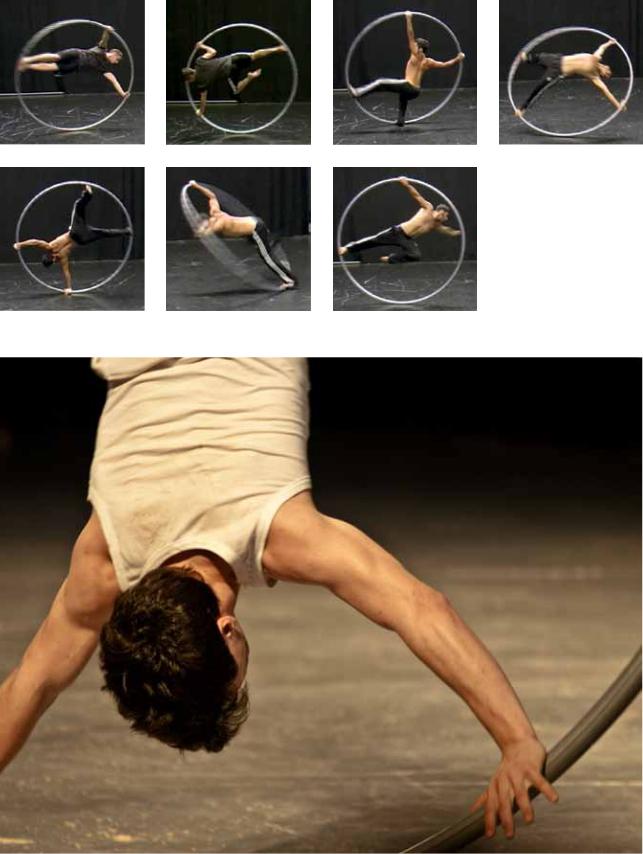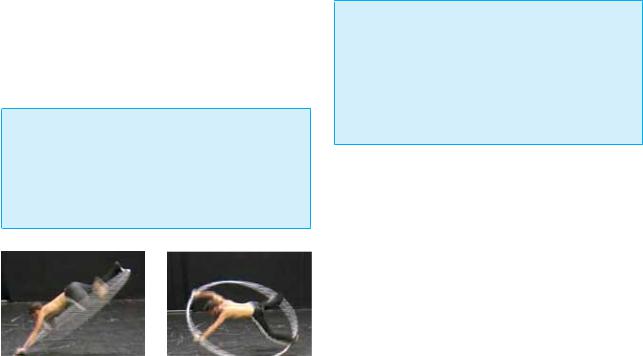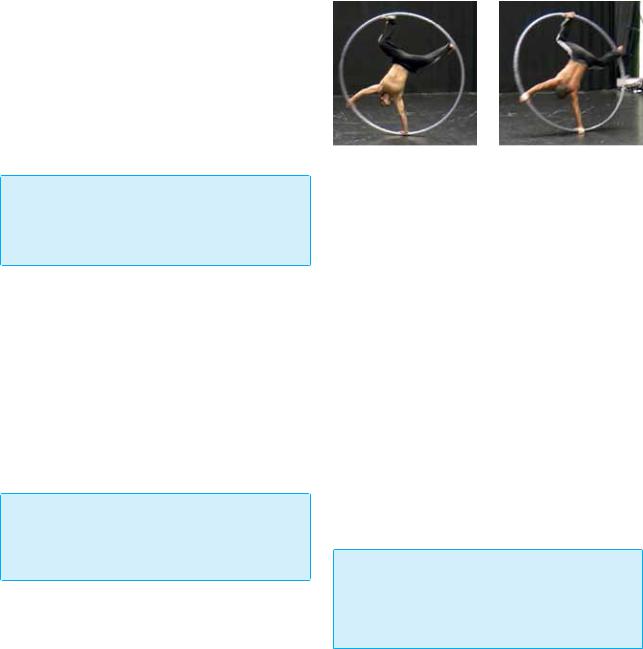
fedec_cyrwheelmanual_en_2011
.pdf
01 |
|
02 |
|
03 |
|
04 |
05 |
|
06 |
|
07 |
© fedec 2011 |
CYR WHEEL 39 |

CARTWHEELS AND COINS
1
CARTWHEELS
1.1 Circular cartwheel. BASIC
–Same principle as the one previously described (see Straight line),
–the arm and leg pushing is slightly towards the inside of the circular trajectory ,
–the wheel is therefore tilted towards the inside,
–your body stays slightly outside the wheel,
–possible to do it in the other direction.
AIMS
–Being aware that hands and feet always give the sense of direction.
–Visualising in advance the trajectory we wish to follow in space.
1.2Straight cartwheel BASIC
–Start from standing and spin the wheel in a straight line like an “acrobatic” wheel, by putting one foot slightly higher than usual on the side of the wheel,
–push the wheel to the ground with that foot to set the wheel in motion,
–follow the wheel with your body in a tensioned position, you will find yourself with your legs wider apart than usual,
–when your hand or foot are on floor level, the arm or leg is stretched
–your body stays inside the wheel,
–it is possible to do it in the other direction.
AIMS
–Being aware that hands and feet always give the sense of direction.
–Visualising in advance the trajectory we wish to follow in space.
1.3 The “figure of 8” (combination of 2 wheels in opposite directions) INTERMEDIATE
–Perform a circular wheel as described above,
–when the body straightens up (vertical position), do a half turn forward in the opposite direction of the wheel (turn in circles towards the right /half turn left)(your right arm and left leg move),
–turn the left hand with palms upward towards the starting position,
–continue with a cartwheel in the opposite direction,
–draw a “figure of 8”.
AIMS
–Being aware that hands and feet always give the sense of direction.
–Visualising in advance the trajectory we wish to follow in space.
1.4Cartwheel-Full turncartwheel ADVANCED As an entrance.
– get into the wheel as if you were going to do a cartwheel,
– put the first leg at floor level (turn left/right leg),
– put the second leg further away (cross),
– at the same time let go of the opposite arm to catch the wheel behind with palm up (first half turn),
– let go of the other arm with the opposite leg to catch the wheel in its starting position (second half turn),
– continue with a cartwheel.
Starting from the cartwheel
–do a circular cartwheel as described above,
–when your body straightens up (vertical position), do a half turn backwards in the direction opposite to the wheel (turn in circles towards the right/half turn left)(your left leg and right arm move)
–after a half turn forward in the opposite direction to the wheel (your left arm and right leg move),
–continue with cartwheels in circles.
40 CYR WHEEL |
© fedec 2011 |

1.5 The “S shape” (half wheel in closed position – half wheel in open position).
(Preparation for back flip) INTERMEDIATE
–To get used to opening backwards,
–do a half cartwheel forward,
–when the second hand touches the floor, pull the wheel back (on top of your head) by opening your shoulders and hips,
–push the wheel to the ground with your legs (one after the other) by keeping your body open (shoulders/hips),
–this is the second part of the backward cartwheel (opening).
AIMS
–Using the body weight to put hands down on the floor.
–Keeping the back open and the spine extended at the same time as having a good grip of feet and hands on the wheel.
2
COINS
2.1 


 Big forward coins. BASIC
Big forward coins. BASIC
–Slow down the rhythm of the basic step,
–when doing the half turn forward, tilt the wheel forward and go down with one hand that pushes the wheel to the floor, followed by the other hand (straighten one arm, pull the wheel upwards with the other arm)
–at the same time, remain in a tensioned position inside the wheel and take the wheel upwards with your feet and bent legs,
–when the second hand goes past the floor, push the wheel to the floor with one foot followed by the other (and stretch your legs),
–at the same time, pull the wheel upwards with bent arms,
–after the second leg has gone past the floor, push again with your arms, etc..
–Throughout the movement keep your body in a “dish” position
–TIP: tip it off balance forward and stay inside the wheel!
AIMS
–Using your body weight to lower your hands to the floor.
–Bending the back slightly to try and open up and finding the good gripping points on the wheel for hands and feet.
01 |
|
02 |
|
03 |
|
04 |
|
© fedec 2011 |
|
|
CYR WHEEL 41 |
|

2.2 Right/left transfer (change of direction) BASIC
–Put yourself inside the wheel with one foot at floor level, the other foot (bent leg) more on the side of the wheel with the all your body weight on the first foot,
–push the wheel towards the floor with the second foot and bend the leg of the first foot,
–the wheel slides in your hands from one side to the other,
–do all this while keeping the wheel in front of your body,
–it is the hand opposite the supporting leg that keeps the wheel balanced.
2.3 Transfer to the big coin towards the right to continue in a coin position towards the left
INTERMEDIATE
2.4 
 Small forward coins INTERMEDIATE
Small forward coins INTERMEDIATE
–Perform the same movement as in the big coins,
–speed up the rhythm of pulling/pushing with your arms and legs,
–pull the wheel less with your feet, towards the top.
AIMS
–Using your body weight to lower your hands to the floor.
–Bending the back slightly to try and open up and finding the good gripping points on the wheel for hands and feet.
2.5 Backward coins ADVANCED
–The “S shape” (half coin forward into half coin backwards) as preparation. (see p.41)
–Backward coin
–Start the movement as the flip (see p.40), well opened up (stretched arms and really come out of the wheel with your whole body),
–after putting down your first hand, keep
your shoulders open and push the wheel to the floor with your second hand,
–when the second hand touches the floor, keep the wheel behind with your legs (backwards),
–push the wheel to the floor with your leg (bend), (taking your time so that the wheel spins from
the hand to the first foot) while keeping your body open (shoulders/hips),
–push the wheel to the ground with your second leg while keeping the wheel behind with your arms (see “S” p.41).
AIMS
–Losing balance and falling backwards before putting the first hand on the ground.
–Having a good open body shape (shoulders, back, pelvis, knees).
–Maintaining a good grip of both hands and feet on the wheel.
01 |
|
02 |
42 CYR WHEEL |
© fedec 2011 |

SPINNING ON ONE ARM
Centreing on one arm INTERMEDIATE
–Perform small coins to generate speed,
–make the coins wider (step onto the wheel with your feet),
–when the first hand (left turn/right hand) is at floor level, place the wheel exactly on top of your head (your body stays inside/in the middle of the wheel),
–pull with the other arm to maintain this position on one arm.
AIMS
–Making sure the pelvis doesn’t go backwards, keeping your body straight and your spine in good alignment, inside the wheel.
Centreing “in the middle of” the wheel (two hands not touching the floor) INTERMEDIATE
–Same principle as centreing on one arm,
–when the first hand is at floor level, place the wheel slightly above your head with your feet (your body is perfectly straight and the wheel leans slightly below it, like in the standing up centreing position),
–instead of pulling with the other arm
(to stay on one arm), stretch your arms and spin to the middle of the wheel
–go down on the first hand.
AIMS
–Making sure the pelvis doesn’t go backwards, keeping your body straight and your spine in good alignment, inside the wheel.
01 |
|
01 |

 Transfer from the first arm to the second and back to the first arm INTERMEDIATE
Transfer from the first arm to the second and back to the first arm INTERMEDIATE
Même principe que centrer sur un bras,
–Same principles as centreing on one arm,
–when the first hand is at floor level and the wheel is perfectly above your head, transfer your body weight towards the other hand by pushing the wheel further, on top of your head, with your feet (your body will be more open on the second hand),
–come back to the first hand by “withdrawing” the wheel towards a more vertical position (the body will find itself in a straighter/more vertical position)
–help by pushing with your arms towards the middle of the circular trajectory
–put emphasis on the feet pushing on the wheel; maintain contact!!!
Same basic step reversed ADVANCED
–Same principle as described above with the transfer of one hand towards the other but continuously until you decide to come down.
AIMS
–Opportunity to work on speed: acceleration and deceleration and different space trajectories: big, small and/or in a curved or straight line.
© fedec 2011 |
CYR WHEEL 43 |

ENTRANCES
1
In front
1.1 One foot BASIC
–Come into the wheel with one foot when the wheel is in front of you (left turn/right/left foot), then put the other foot apart (45 degrees),
–the first foot goes on the wheel at floor level,
–start with the wheel in vertical position (do not tilt it too much).
1.2 two feet BASIC
–Hang from two bent arms then put your feet down at the same time (or with a slight delay) on the wheel.
1.3 SUPERMAN
–Start as before “come into the wheel with one foot forward” (see above),
–when setting the wheel in motion, “centre” it as much as possible,
–instead of putting the foot on the wheel, raise your two heels towards the back by arching your body (open shoulders, back and hips),
–stay slightly “on standby” with your legs and hands in the opposite direction to the rotation of the wheel (left turn/stay right),
–your body will slowly find itself in a perpendicular position to the wheel,
–you could close and bend your legs, put your feet on the wheel or continue in a grouped hanging position
–(see above basic step in grouped hanging position)
–the same principle is possible with bent arms.
2
Behind.
2.1 One foot BASIC
–Place yourself in the middle of the wheel rotating in a coin position (basketball),
–go inside the wheel with one foot
(left turn/right foot) when the wheel is behind you, then put the other foot in.
–the foot goes on the wheel at floor level.
–help with your arms to make the wheel turn well.
2.2 Two feet BASIC
–Place yourself in the middle of the wheel rotating in a coin position (basketball),
–hang with two bent arms and head in front of the wheel then put down two feet on the wheel at the same time.
INTENTIONS
–Feeling the movement of the wheel (rotational speed and trajectory) every time you enter, so that the body can adapt. Once you are in, letting yourself be transported by that movement before manipulating the wheel to perform a move.
44 CYR WHEEL |
© fedec 2011 |

EXITS
1
Starting from your feet
1.1 Simple BASIC
–Come out of the wheel in the half turn forward, in the basic step putting one foot down (left turn/right foot) then the other one in front of the wheel,
–maintain contact with the wheel with one hand.
–Come out of the wheel in the half turn backwards in the basic step, putting one foot down (left turn/right foot) and the other one in front of the wheel,
–maintain contact with the wheel with one hand.
1.2 Starting from the wheel INTERMEDIATE
–The moment the feet come close to the ground,
put the first foot down and put it in front of the wheel (left turn/right foot),
–followed by the second (right),
–at the same time as the opposite hand,
–the second hand follows the wheel,
–at the same time take a crouched position in the middle of the circle of the wheel.
1.3 Starting from the position “centre without hands” ADVANCED
–Centre (your body inside the wheel),
–look in the direction of the rotation (slight profile position),
–let the hands go at the same time and lower them,
–do a turn without hands,
–when the wheel tilts forward (half turn forward), descend with your two feet together in front of the wheel (inside the circle of the wheel),
–control the movement of the wheel with one hand and exit towards the external side of the wheel.
2
Starting
from hands ADVANCED
–Start as if centreing on one hand in reversed position,
–when the wheel tilts towards the position on the second hand, push the wheel above your head with your feet and then let your feet go,
–go back to the forward-facing direction to straighten yourself up,
–your hands follow and control the wheel movement.
3
Starting
from hanging INTERMEDIATE
–Bend your legs in order to straighten your arms completely (hanging position),
–when doing the half turn backwards, put one leg out at the front (left turn/left leg),
–bring the second leg to the first hanging with the wheel behind you,
–put the first leg on the floor (left turn/right leg),
–followed by the second,
–keep moving the wheel with your hands,
–can end with a half turn towards the wheel to stop the wheel with two hands.
AIMS
–If you decide to exit using the movement you were doing inside the wheel, you have to slow down little by little and be aware of the wheel trajectory to go further away from it or stay centred (possibility to manipulate the wheel in that moment).
–If you want to stop suddenly, you must think about anchoring strongly on the floor to stop your body’s speed.
© fedec 2011 |
CYR WHEEL 45 |

2
Complementary Workshop
Dance and Movement
A movement workshop can be useful for the technical and artistic development of the circus artist, alongside teaching of how to use the Cyr wheel.
A complementary movement workshop can be based on one approach (for example: technical release, floor work, contact, improvisation) or on a combination of different approaches.
This will improve the students’ sensitivity and awareness and will help them build their body and become more aware of it using their senses and their feelings, before, during and after the movement. This starts with searching for an anchoring to the ground by establishing bases of support (vertically, with hands and feet, horizontally with different body parts such as the back, pelvis, head, arms etc.); searching for the body centre as a result of forces exerted upon the body, a point where forces cancel each other out, an anchoring point around which the body arranges itself; releasing the body and using gravity to relieve muscular tension and working with the correct amount of energy in relation to the effort required.
By adding the sense of direction the body finds its positioning within space; it draws and creates volume and generates spatial tensions that are constantly stimulating, in order to build and develop a choreographed material which can be integrated into work with a piece of apparatus. By integrating breathing, students understand the notion of suspension, impulsion, attack, new impetus, as well as heaviness and lightness.
The actions of touching, rolling and sliding of different body parts (hands and feet, but also pelvis, head, back arms etc) will help students to widen their vocabulary and keep in touch with their feelings; to know how to position themselves in their performance space; to discover endless spatial orientations and different heights (high, middle, low) in order to familiarise themselves with their own sphere of movement.
Improvisation is a technique which helps students develop their autonomy, their artistic intelligence and kinaesthetic creativity as well as give a space and time dimension to their body and movement work. This could give a new impetus to their own personal work around their discipline.
Improvisation helps students to be receptive to the rhythm of movement, of phrases and sequences, to sound or silence whilst making themselves available and being exploratative. It helps them search for personalisation when faced with different options, to move in the direction of their own feelings, to work in the here and now in order to make the movement real and to clarify their intentions so that they are easier to interpret.
© fedec 2011 |
CYR WHEEL 47 |
3
Specific physical conditioning
The Cyr wheel is an activity which puts a huge demand on the muscular and cardiovascular systems, when practised at a high level. The student’s initial physical condition, the length of the piece, its technical difficulty and density will determine the student’s specific aims in physical conditioning.
Planning the specific conditioning used in the Cyr wheel takes into consideration the following four ideas:
–Identifying energy systems
–Identifying the main muscular actions
–Identifying potential injury areas
–Identifying the antagonistic muscles in main movements
Identifying energy systems
A Cyr wheel act generally lasts 4 to 8 minutes; it often has an uninterrupted movement and frequent variations of intensity which places a demand on the aerobic system. The anaerobic system is also under pressure during the whole act through the variation of repetitive muscular contractions and intensity during the performance. Both these systems should therefore be trained, in order to make the performance of a Cyr wheel act easier.
In concrete terms, indoor training could include aerobic work with short intervals (e.g. 30 seconds at 100% intensity and 30 seconds at 70% intensity) and uninterrupted (e.g. between 80% and 95% of the estimated maximum heart rate).
During the discipline training we could specifically train these qualities by progressively repeating sequences of movements, with an increasing frequency, or, by repeating the act successive times in a row. This could be done nearer the time of the assessed performance.
Identifying the main muscular actions
Generally speaking, the movements which are most often found in Cyr wheel are holding a variety of body tension shapes (e.g. coins, basic steps, basic steps without legs…), leg pushes (e.g. jump into a pull up with straight arms, dish…) and arm pulling (e.g. climbing, flags …). These movements should be a priority in the goals of a conditioning/training programme.
Exercises performed in the weights room/gym should take into consideration these movements and body tension shapes and form part of the fundamental baselevel physical conditioning programme. Likewise, the more physically challenging, technical Cyr wheel moves performed by the students should also determine specific exercise selection, which should ultimately improve performance of the specific movements being trained in the discipline.
For example, if a student chooses to do a basic step on his/her hands, a specific strength exercise for his/her shoulders could be included into the training programme. An example could be an endurance handstand exercise with hands set at a specific width.
Some exercises can also be undertaken during technical training sessions’ movements. For example, for the basic step on hands, the student can be held in a handstand by the trainer, inside the wheel, in order to develop strength/endurance in his/her shoulders. Subsequently, forward and backwards tilting movements can be added to include the flexor/extensor muscle chains. Once the student reaches sufficient levels of strength and endurance required to maintain these positions, the trainer can assist the basic step movement on the hands by guiding the rotation of the wheel like he/she does during the learning of the basic steps.
48 CYR WHEEL |
© fedec 2011 |
